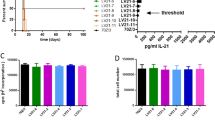Summary
BALB/c mice inoculated IP with a syngeneic plasmacytoma MOPC 104E were treated with a combination of a streptococcal preparation, OK-432 (1 KE, 0.1 mg/mouse), low-dose of cy clophosphamide (CPA, 1 mg/kg) and adoptive transfer of tumor-bearer-spleen cells (2 x 10' cells) cultured with IL2 and sonicated tumor extract (adoptive immunotherapy; AIT). The consecutive protocol of OK-432 (day 8, 9 post inoculation) — CPA (day 10) — AIT (day 11) was the most effective. Rate of complete remission was highest when recombinant (r-) IL2 was injected to the mice after AIT. Moreover, another bacterial preparation,Nocardia rubra cell wall skeleton and another low-dose chemotherapy, Mitomycin C could be used successfully instead of OK-432 or CPA. Transfer test of intraperitoneal cells (tumor cells plus host cells) of mice on day 11 post inoculation (on the day of AIT) revealed that OK-432 augmented the susceptibility of peritoneal cells to cultured lymphocytes in inhibition of transplantability, and that CPA after OK-432 augmented the anti-tumor effect of tumor-bearer-spleen cells which act synergistically with cultured lymphocytes. This therapy schedule seems to be the best model to augment the effect of AIT with minimal side effect.
Similar content being viewed by others
Abbreviations
- AIT:
-
adoptive immunotherapy
- CL:
-
cultured lymphocytes
References
Cheever MA, Greenberg PD, Fefer A. Specific adoptive therapy of established leukemia with syngeneic lymphocytes sequentially immunized in vivo and in vitro and nonspecifically expanded by culture with interleukin 2. J Immunol 126: 1318–22, 1981.
Eberlein TJ, Rosenstein M, Spiess P, Wesley R, Rosenberg SA. Adoptive chemoinununotherapy of a syngeneic murine lymphoma with long-term lymphoid cell lines expanded in T cell growth factor. Cancer Immunol Immunother 13: 5–13, 1982.
Cheever MA, Greenberg PD, Fefer A, Gillis S. Augmentation of the anti-tumor therapeutic efficacy of long-term cultured T lymphocytes by in vivo administration of purified interleukin 2. J Exp Med 155: 968–80, 1982.
Kan N, Ohgaki K, Inamoto T, Kodama H. Antitumor and therapeutic effects of spleen cells from tumor-bearing mice cultured with T cell growth factor and soluble tumor extract. Cancer Immunol Immunother 18: 215–22, 1984.
Kan N, Inamoto T, Hori T, Nio Y, Tsuchitani T, Kodama H, Tobe T, Ohgaki K. Adoptive immunotherapy of murine tumor using cultured syngeneic tumor-bearer spleen cells: Therapeutic effect of cultured lymphocytes against malignant ascites and its augmentation by streptococcal preparation, OK-432. J Jpn Soc Cancer Ther 20: 784–96, 1985.
Kan N, Hori T, Okino T, Imai S, Ohgaki K, Tobe T. Synergistic anti-tumor effect of host's lymphocytes and lymphocytes cultured with IL-2 in OK-432-combined adoptive immunotherapy. Abstract of the 14th International Cancer Congress (1): 144, 1986.
Masuno T, Hayashi S, Ito M, Ikeda T, Ogura T, Kishimoto S, Yamamura Y. Mechanism(s) of in vitro macrophage activation with Nocardia rubra cell wall skeleton: The effects on macrophage activating factor production by lymphocytes. Cancer Immunol Immunother 22: 132–38, 1986.
Koyama S, Ozaki A, Iwasaki Y, Sakita T, Osuga T, Watanabe A, Suzuki M, Kawasaki T, Soma T, Tabuchi T, Nakayama N, Koizumi S, Yokoyama K, Uchida T, Orii K, Tanaka T. Randomized controlled study of postoperative adjuvant immunotherapy with Nocardia rubra cell wall skeleton (N-CWS) and Tegafur for gastric carcinoma. Cancer Immunol Immunother 22: 148–54, 1986.
Taguchi T, Urushizaki T, Koyama I, Saito T, Niijima T, Takakura K, Izuo M, Ikeda S, Kondo T, Kimura K, Ohta K, Akaboshi Y, Ogura T, Hattori T. Phase 1 trial of recombinant interleukin-2 (TGP-3). In: Ishigame J, eds. Recent advances in chemotherapy. Tokyo: Tokyo University Press, 1985, 804–5.
Rosenberg SA, Lotze MT, Muul LM, Chang AE, Avis FP, Leitman S, Linehan WM, Robertson CN, Lee RE, Rubin JT, Seipp CA, Simpson CG, White DE. A progress report on the treatment of 157 patients with advanced cancer using lymphokine-activated killer cells and interleukin-2 or high-dose interleukin-2 alone. New Engl J Med 316: 889–97, 1987.
Hattori T, Yamamoto S, Satoh H, Funasaka M, Furue H. Experimental and clinical studies on combination therapy of anticancer drugs with OK-432. Jpn J Cancer Clin 19: 929–34, 1973.
Koshimura S, Ryoyama K. Enhancement of antileukemic effect in the combination of 5-fluorouracil and OK-432. Cancer Treat Rep 61: 17–27, 1977.
Saito M, Sugawara Y, Ogawa H, Ota K. Combined effect of intraperitoneally administered adriamycin and OK-432 against Meth-A ascites tumor. Jpn J Cancer Chemother 6: 1101–7, 1979.
Hanna MG, Key ME. Immunotherapy of metastases enhances subsequent chemotherapy. Science 217: 367–9, 1982.
Lubet RA, Carlson DE. Tumor immunity directed against MOPC104E: Effect of various therapeutic regimens. Cancer Immunol Immunother 2: 267–70, 1977.
Torisu M, Katano M, Kimura Y, Itoh H, Takesue M. New approach to management of malignant ascites with a streptococcal preparation, OK-432. 1. Improvement of host immunity and prolongation of survival. Surgery 93: 357–64, 1983.
Kan N, Okino T, Nakanishi M, Satoh K, Ohgaki K, Tobe T.In vivo andin vitro synergistic anti-tumor effect of IL2-cultured tumor-bearer-spleen cells and immune fresh spleen cells. Cancer Immunol Immunother 28: 260–6, 1989.
Mills GD, North RJ. Expression of passively transferred immunity against an established tumor depends on generation of cytolytic T cells in recipient: Inhibition by suppressor cells. J Exp Med 157: 1448–60, 1983.
Rosenstein M, Eberline TJ, Rosenberg SA. Adoptive immunotherapy of established syngeneic solid tumors: Role of T lymphoid populations. J Immunol 132: 2117–22, 1984.
Hori T, Kan N, Nio Y, Tsuchitani T, Inamoto T, Kodama H, Tobe T. Augmentation by OK-432 of cytotoxic activities of lymphocytes in carcinomatous pleural effusions, and its application for adoptive immunotherapy. In: Tobe T, eds. New applications of OK-432. Tokyo: Exerpta Medica, 1986: 132–40.
Author information
Authors and Affiliations
Rights and permissions
About this article
Cite this article
Kan, N., Okino, T., Nakanishi, M. et al. Therapeutic efficacy of sequential therapy with OK-432, cyclophosphamide, IL2-cultured lymphocytes andin vivo IL2 against advanced murine plasmacytoma. Biotherapy 1, 197–206 (1989). https://doi.org/10.1007/BF02170888
Received:
Accepted:
Issue Date:
DOI: https://doi.org/10.1007/BF02170888



